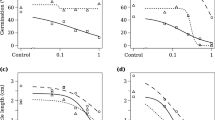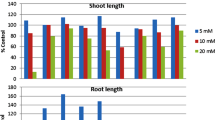Abstract
This study was designed to evaluate the inhibitory potential of plant extract and essential oils (EOs) extracted from Artemisia abyssinica, Cinnamomum verum, Cymbopogon citratus, C. martinii, C. winterianus, Curcuma longa, Cupressus lusitanica, Eucalyptus citriodora, E. globules, Lantana camara, Rosmarinus officinalis, and Thymus schimperi against some of the most troublesome weed species in the coffee field via a series of lath-house and field conditions using various application frequencies at the rate of 5% (v/v) arranged in RCBD with three replications. Our result showed that EOs significantly reduced the shoot height (58 to 100%) and root length (52 to 100%) as well as total biomass of G. parviflora seedlings compared to untreated control. The inhibitory effects were measured to be varied among EOs of the tested plants followed application frequencies dependent manner. The potential herbicidal properties of EOs from selected plants based on their efficacy in the lath-house experiments were further tested against weeds of coffee under the field. Except for EO from E. citriodora, all the tested materials showed strong inhibitory effects (ranging from 23.22 to 46.27%) on all weed species compared to untreated control. In conclusion, the application of EOs from Cymbopogon species had the potential to retard the growth of weeds in coffee and may be used as a component of integrated weed management options. However, further study needs to be done to investigate the mechanism of inhibition and the exact active ingredient responsible for the inhibitory effects.




Similar content being viewed by others
References
Abbott WS (1925) A method of computing the effectiveness of an insecticide. J Econ Entomol 18:265–267
Alipour M, Saharkhiz MJ, Niakousari M, Damyeh MS (2019) Phytotoxicity of encapsulated essential oil of rosemary on germination and morphophysiological features of amaranth and radish seedlings. Sci Hortic 243:131–139
Almarie AA, Mamat AS, Wahab Z (2016) Allelopathic potentil of Cymbopogon citratus against differentweed species. Indian Res J Pharm Sci 3:324–330
Batish DR, Singh HP, Setia N, Kaur S, Kohli RK (2006) Chemical composition and phytotoxicity of volatile essential oil from intact and fallen leaves of Eucalyptus citriodora. J Biosci 61:465–471
Batish DR, Singh HP, Setia N, Kohli RK, Kaur S, Yadav SS (2007) Alternative control of littleseed canary grass using eucalypt oil. Agron Sustain Dev 27:171–177
Batish DR, Singh HP, Kohli RK, Kaur S (2008) Eucalyptus essential oil as a natural pesticide. For Ecol Manag 256:2166–2174
Benchaa S, Hazzit M, Abdelkrim H (2018) Allelopathic effect of Eucalyptus citriodora essential oil and its potential use as bioherbicide. Chem Biodivers 15:1–9
Benchaa S, Hazzit M, Zermane N, Abdelkrim H (2019) Chemical composition and herbicidal activity of essential oils from two Labiatae species from Algeria. J Essent Oil Res 31:335–346
Buss EA, Park-Brown SG (2002) Natural products for insect pest management. ENY-350, Department of Entomology and Nematology, Florida Cooperative Extension Service, Institute of Food and Agricultural Sciences, University of Florida
Davis AP, Tosh J, Ruch N, Fay MF (2011) Growing coffee: Psilanthus (Rubiaceae) subsumed on the basis of molecular and morphological data; implications for the size, morphology, distribution and evolutionary history of Coffea. Bot J Linn Soc 167:357–377
Dayan FE, Duke SO (2010) Natural products for weed management in organic farming in the USA. Outlooks Pest Manag 21:156–160
El-Rokiek K, El-Nagdi W (2011) Dual effects of leaf extracts of Eucalyptus citriodora on controlling purslane and root-knot nematode in sunflower. J Plant Prot Res 51:121–129
Eshetu T, Tefera W, Kebede T (2007) Effect of weed management on pineapple growth and yield. Eth J Weed Mgt 1:29–40
Fouad R, Bousta D, Lalami AEO, Chahdi FO, Amri I, Jamoussi B, Greche H (2015) Chemical composition and herbicidal effects of essential oils of Cymbopogon citratus (DC) Stapf, Eucalyptus cladocalyx, Origanum vulgare L and Artemisia absinthium L. cultivated in Morocco. J Essent Oil-Bear Plants 18:112–123
Francom M, Tefera A (2016) Ethiopia: coffee annual, coffee production and exports remain steady. USAD Foreign Agriculture Service, Addis Ababa
Gella D, Ashagre H, Negewo T (2013) Allelopathic effect of aqueous extracts of major weed species plant parts on germination and growth of wheat. J Agric Crop Res 1:30–35
Getachew Z (1991) Study of coffee weed flora and the possible control measures in coffee stage farms. An MSc Thesis presented to the school of Graduate studies of Alemaya University, Alemaya, Ethiopia
Grahovac NL, Stojanović ZS, Kravić SŽ, Orčić DZ, Suturović ZJ, Kondić-Špika AĐ, Vasin JR, Šunjk DB, Jakšić SP, Rajković MM, Grahovac NM (2017) Determination of residues of sulfonylurea herbicides in soil by using microwave-assisted extraction and high performance liquid chromatographic method. Hem Ind 71:289–298
Grul’ová D, Caputo L, Elshafie HS, Baranová B, De Martine L, Sedlák V, Gogal’ová Z, Poráčová J, Camele I, De Feo V (2020) Thymol chemotype Origanum vulgare L. essential oil as a potential selective bio-based herbicide on monocot plant species. Molecules 25:595
Hazrati H, Saharkhiz MJ, Moein M, Khoshghalb H (2018) Phytotoxic effects of several essential oils on two weed species and tomato. Biocatal Agric Biotechnol 13:204–212
Heap I (2014) Global perspective of herbicide-resistant weeds. Pest Manag Sci 70:1306–1315
Hodge S, Merfield CN, Bluon A, Berry NA, O’Connell DM (2019) The potential of culinary vegetable oils as herbicides in organic farming: the effect of oil type and repeated applications on plant growth. Org Agric 9:41–51
Ibáñez MD, Blázquez MA (2018) Phytotoxicity of essential oils on selected weeds: potential hazard on food crops. Plants 7:79
ICO (2019) Coffee Development Report. http://www.ico.org/trade_statistics.asp. Accessed 10 May 2020
Isman M (2000) Plant essential oils for pest and disease management. Crop Prot 19:603–608
Jabran K, Mahajan G, Sardana V, Chauhan BS (2015) Allelopathy for weed control in agricultural systems. Crop Prot 72:57–65
Kaur S, Singh HP, Mittal S, Batish DR, Kohli RK (2010) Phytotoxic effects of volatile oil from Artemisia scoparia against weeds and its possible use as a bioherbicide. Ind Crops Prod 32:54–61
Kimani M, Little T, Vos JG (2002) Introduction to coffee management through discovery learning CAB International African Regional Centre, Nairobi, Kenya:2
Labouisse J-P, Bellachew B, Kotecha S, Bertrand B (2008) Current status of coffee (Coffea arabica L.) genetic resources in Ethiopia: implications for conservation. Genet Resour Crop Evol 55:1079–1093
Lanini WT (2010) Organic herbicides-do they work Calif. Weed Sci Soc J 6:1–3
Lashermes P, Combes M-C, Ansaldi C, Gichuru E, Noir S (2011) Analysis of alien introgression in coffee tree (Coffea arabica L.). Mol Breed 27:223–232
Lingenfelter DD, Hartwig NL (2007) Introduction to Weeds and Herbicides,The Pennsylvania State University, College of Agricultural Sciences Agricultural Research and Cooperative Extension
Marwat KB, Saeed M, Hussain Z, Gul B, Rashid H (2008) Study of various herbicides for weed control in wheat under irrigated conditions. Pak J Weed Sci Res 14:1–8
Mehdizadeh M, Mushtaq W (2020) Biological control of weeds by allelopathic compounds from different plants: a bioherbicide approach. Natural remedies for pest, disease and weed control. Academic Press, New York, pp 107–117
Mehdizadeh M, Alebrahim MT, Roushani M (2017) Determination of two sulfonylurea herbicides residues in soil environment using HPLC and phytotoxicity of these herbicides by lentil bioassay. Bull Environ Contam Toxicol 99:93–99
Morgan E, Overholt W (2005) Potential allelopathic effects of Brazilian pepper (Schinus terebinthifolius Raddi, Anacardiaceae) aqueous extract on germination and growth of selected Florida native plants. J Torrey Bot Soc 132:11–15
Mushtaq W, Mehdizade M, Siddiqui MB, Ozturk M, Jabran K, Altay V (2017) Phytotoxicity of above-ground weed residue against some crops and weeds. Pak J Bot 52:3
Mutlu S, Atici Ö, Esim N, Mete E (2011) Essential oils of catmint (Nepeta meyeri Benth.) induce oxidative stress in early seedlings of various weed species. Acta Physiol Plant 33:943–951
Nyabundi K, Kimemia J (1998) Difficult weeds in Kenya coffee-a review. Kenya Coffee 63:2747–2751
Othman AS, El-Zemaity M, Dahroug S, Hanafi A (2020) Herbicidal activity of allelopathic extracts of sorghum and some herbicides on wheat and accompanied weeds. J Res Weed Sci 3:451–464
Pacanoski Z, Dimov Z (2017) Selectivity and efficiency of some herbicides against weeds applied to alkaloid poppy (Papaver somniferum L.). In: Paper presented at the 52nd Croatian and 12th International Symposium on Agriculture, February 12–17, 2017, Dubrovnik, Croatia
Paudel V, Gupta V (2008) Effect of some essential oils on seed germination and seedling length of Parthenium hysterophorous L. Ecoprint Int J Ecol 15:69–73
Poonpaiboonpipat T, Pangnakorn U, Suvunnamek U, Teerarak M, Charoenying P, Laosinwattana C (2013) Phytotoxic effects of essential oil from Cymbopogon citratus and its physiological mechanisms on barnyardgrass (Echinochloa crus-galli). Ind Crops Prod 41:403–407
Rainbird B, Bentham R, Soole K (2018) Rhizoremediation of residual sulfonylurea herbicides in agricultural soils using Lens culinaris and a commercial supplement. Int J Phytoremediation 20:104–113
Rana SS, Rana M (2016) Principles and practices of weed management, Department of Agronomy, College of Agriculture, CSK Himachal Pradesh Krishi Vishvavidyalaya, Palampur
Ranitha M, Abdurahman H, Ziad A, Azhari H, Thana R (2014) A comparative study of lemongrass (Cymbopogon Citratus) essential oil extracted by microwave-assisted hydrodistillation (MAHD) and conventional hydrodistillation (HD) method. Int J Chem Eng Appl 5:104–108
Ronchi C, Silva A (2006) Effects of weed species competition on the growth of young coffee plants. Planta Daninha 24:415–423
Schulz H, Glaser B (2012) Effects of biochar compared to organic and inorganic fertilizers on soil quality and plant growth in a greenhouse experiment. J Plant Nutr Soil Sci 175:410–422
Sileshi G, Schroth G, Rao MR, Girma H (2008) Weeds, diseases, insect pests and tri-trophic interactions in tropical agroforestry. In: Batish DR, Kohli RK, Jose S, Singh HP (eds) Ecological basis of agroforestry. CRC Press, London, UK, pp 73–94
Singh HP, Kaur S, Mittal S, Batish DR, Kohli RK (2009) Essential oil of Artemisia scoparia inhibits plant growth by generating reactive oxygen species and causing oxidative damage. J Cheml Ecol 35:154–162
Soltys D, Krasuska U, Bogatek R, Gniazdowska A (2013) Allelochemicals as bioherbicides-present and perspectives. Herbicides-current research and case studies in use. InTech, London
Travlos I, Rapti E, Gazoulis I, Kanatas P, Tataridas A, Kakabouki I, Papastylianou P (2020) The herbicidal potential of different pelargonic acid products and essential oils against several important weed species. Agron 10:1687
Tworkoski T (2002) Herbicide effects of essential oils. Weed Sci 50:425–431
Ulukanli Z, Cenet M, Ince H, Yilmaztekin M (2018) Antimicrobial and herbicidal activities of the essential oil from the Mediterranean Thymus eigii. J Essent Oil-Bear Plants 21:214–222
USDA (United States Department of Agriculture) (2021) Coffee: world markets and trade, foreing agricultural services. USDA Global Market Analysis, Addis ababa
USDA (United States Department of Agriculture) (2019) Coffee Annual Report, GAIN Report Number: ET1904. https://apps.fas.usda.gov/newgainapi/api/report. Accessed 28 Oct 2020
Verdeguer M, Torres-Pagan N, Muñoz M, Jouini A, García-Plasencia S, Chincilla P, Berbegal M, Salamone A, Agnello S, Carrubba A, Cabeiras-Freijanes L, Regueira-Marcos L, Sánchez-Moreiras A, Blázquez MA (2020) Herbicidal activity of Thymbra capitata (L.) Cav. essential oil. Molecules 25:2832
Wakjira M, Berecha G, Bulti B (2011) Phytotoxic effects of multi-purpose tree species on germination and growth of Parthenium hysterophorus L. Int J Agric Res 6:149–162
Wu J, Ma JJ, Liu B, Huang L, Sang XQ, Zhou LJ (2017) Herbicidal spectrum, absorption and transportation, and physiological effect on Bidens pilosa of the natural alkaloid berberine. J Agric Food Chem 65(30):6100–6113
Acknowledgements
The authors wish to extend their thanks and appreciation to Jimma University College of Agriculture and Veterinary Medicine for financially supporting (Grant number AgVm HpSc/17/01) and providing the necessary laboratory equipment and facilities.
Author information
Authors and Affiliations
Corresponding author
Ethics declarations
Conflict of interest
The authors declare that they have no conflict of interest.
Additional information
Communicated by F. Araniti .
Publisher's Note
Springer Nature remains neutral with regard to jurisdictional claims in published maps and institutional affiliations.
Rights and permissions
About this article
Cite this article
Daba, A., Berecha, G. & Tadesse, M. Herbicidal effects of essential oils from selected plant species against common coffee (Coffea arabica L.) weed species. Acta Physiol Plant 43, 162 (2021). https://doi.org/10.1007/s11738-021-03337-8
Received:
Revised:
Accepted:
Published:
DOI: https://doi.org/10.1007/s11738-021-03337-8




